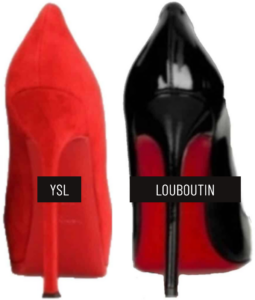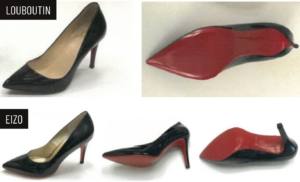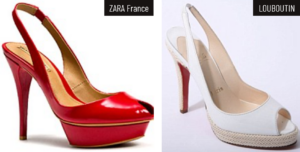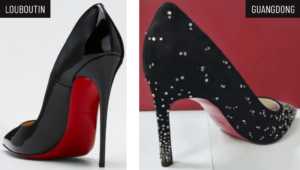The Worldwide Trademark Battle over the Iconic Red Bottom Shoe
Written by Cassidy Aranda
INTRODUCTION
Cardi B, Rihanna, Beyoncé, and Lady Gaga: what do all these glamorous celebrities have in common? Christian Louboutin red-soled heels, of course! Christian Louboutin’s iconic red-soled shoes have graced red carpets, Instagram feeds, and magazine covers worldwide. Louboutin’s signature red soles began the way many iconic fashion pieces are born: through inspiration from an unlikely place. It was 1993, and Christian Louboutin was reworking his latest masterpiece: a “Flowers” by Andy Warhol-inspired shoe. [1] Louboutin stared into the abyss of a “big black sole” while his assistant painted her nails bright red. [2] Louboutin glanced over, and it hit him. [3] He reached for the red nail polish and used it to paint over the black sole. [4] The “signature Louboutin style” was born! [5]
After seeing the success of his shoe, Louboutin filed trademark applications for his red-soled shoe (the “Red Sole Mark”) in, among others, the United States, Mexico, the Philippines, New Zealand, Australia, Bahrain, and Morocco. [6] Filing the trademark applications was only half the battle. Many international courts had differing opinions about Louboutin’s Red Sole Mark. [7] This article discusses Louboutin’s successful and unsuccessful efforts to register and enforce the Red Sole Mark.
First, the Court in the Louboutin v. Yves Saint Laurent case ruled that the Red Sole Mark registered with the United States Patent and Trademark Office does not extend to shoes that have a red body and a red sole. [8] Therefore, Yves Saint Laurent’s (“YSL”) monochrome red shoe did not infringe on Louboutin’s trademark. [9] Second, Louboutin struggled to secure the Red Sole Mark at the Japan Patent Office. [10] Louboutin then unsuccessfully sued Eizo, a Japanese shoe brand, for selling a rubber red sole shoe. [11] The Tokyo Appeal Board concluded that “red-colored heels and shoes have been widely sold before the launch of Louboutin shoes in 1996 in Japan until now.” [12] Third, Louboutin attempted to sue Zara France but failed. [13] Louboutin sued Zara France for the sale of a red bottom shoe that looked like Louboutin’s “Yo-Yo” open-toe pumps. [14] The case made its way to the French Supreme Court, where the judges decided that the red bottom heel “lacked distinctiveness,” and invalidated Louboutin’s trademark. [15] Finally and most recently, Louboutin received a win in the Beijing Intellectual Property Court and the Chinese Supreme Court for infringement of the “red-sole shoes.” [16] Louboutin is still fighting for official trademark recognition in China’s Intellectual Property Court. [17]
I. LOUBOUTIN vs. YVES SAINT LAURENT
In the case of Louboutin v. Yves Saint Laurent, the United States Court of Appeals for the Second Circuit (the “Second Circuit”) overturned the lower court’s finding “that a single color can never serve as a trademark in the fashion industry.” [18] Louboutin sued YSL for trademark infringement after YSL planned to release a line of “monochrome shoes” with an all-red silhouette. [19] Louboutin was concerned that consumers may confuse the YSL red sole for a Louboutin shoe. [20] Louboutin owns the trademark for the Red Sole Mark, described as “lacquered red sole on footwear.” [21] The Second Circuit split its analysis into three parts: (1) whether a single color qualifies as a trademark in the fashion industry and beyond; (2) whether the red sole qualifies as functional; and (3) whether the Lanham Act can protect Louboutin’s red sole trademark. [22] The Second Circuit followed the precedent set forth by the Qualitex case, where the U.S. Supreme Court held that “[t]rademark law . . . prevent[s] other from copying a source-identifying mark” by “assur[ing] a potential customer that this item . . . with this mark is made by the same producer.” [23] Trademark law also “helps assure a producer that it will reap the financial, reputation related rewards associated with a desirable product.” [24] The Appeals Court decided the “Red Sole Mark merits protection . . . when . . . a red outsole contrast[s] with the remainder of the shoe.” [25] Thus, YSL’s monochromatic shoe did not infringe the Red Sole Mark because the entirety of the YSL shoe is red. [26] The signature Louboutin red heel provides a “contrast between the sole and the upper that causes the sole to ‘pop’ and to distinguish its creator.” [27] Since YSL’s monochrome shoe did not have a popping contrast, the shoe did not infringe the trademark. The Court held that the Red Sole Mark is still enforceable in “situations in which the red lacquered outsole contrasts in color with the adjoining ‘upper’ of the shoe.” [28] Pictures of the YSL shoe compared to the Louboutin shoe can be seen below. [29]

II. CHRISTIAN LOUBOUTIN vs. EIZO COLLECTION COMPANY
This case highlights the importance of and difficulties that come with trademarking a single color in some countries. Securing the Red Sole Mark in Japan is difficult because the Japanese Patent Office (“JPO”) only registers color trademarks when two or more colors are involved. [30] In 2015, Louboutin attempted to trademark its single-color mark. [31] The trademark application has been pending ever since because the JPO believes the Red Sole Mark lacks “inherent and acquired distinctiveness.” [32] In 2018, Louboutin learned that the Eizo Collection Company (“Eizo”) began selling shoes with rubber red soles. [33] Louboutin immediately filed an infringement lawsuit in the Tokyo District Court (the “Tokyo Court”). [34] Louboutin argued that Eizo did not ask Louboutin for permission to use its Red Bottom Mark and, therefore, Eizo was infringing Louboutin’s Red Sole Mark under Japan’s unfair competition law. [35] Louboutin also presented a consumer survey to convince the court that consumers associate red bottoms with Louboutin. [36] However, the Tokyo Court decided that Louboutin’s Red Sole Mark does not warrant protection because shoes with red soles “have been widely distributed even before the launch of Louboutin shoes in Japan.” [37] Louboutin’s survey did not convince the Tokyo Court that the “two decades of use and advertisements” categorizes Louboutin’s red sole as a distinct “source indicator in Japan.” [38] Furthermore, Eizo’s red bottom shoes cost significantly less and include red rubber soles. [39] The Tokyo Court did not believe that consumers could confuse Louboutin’s expensive, luxury “red lacquered sole” with a lower-priced Eizo rubber red sole. [40] The decision to dismiss Louboutin’s remedies request is consistent with JPO’s refusal to grant trademarks to single colors. [41] Louboutin’s future infringement success in Japan therefore likely depends on JPO extending protection to single color marks. Pictures of the Eizo shoe compared to the Louboutin shoe can be seen below. [42]

III. CHRISTIAN LOUBOUTIN vs. ZARA FRANCE
Christian Louboutin received a French trademark for the “red sole of a shoe” in November 2000. [43] Zara France (“Zara”), a fast fashion retailer, began selling a collection of women’s shoes with red bottoms in the late 2000’s. [44] Louboutin immediately filed a lawsuit for “counterfeiting and unfair competition” because one of these designs looked like the “Yo-Yo” Christian Louboutin design. [45] The Paris Court of First Instance (the “First Court”) ruled in favor of Zara paying damages to Louboutin because of Zara’s use of the red bottom design. [46] However, the First Court rejected Louboutin’s trademark infringement claim because “there was no likelihood of confusion between the trademark and the shoes.” [47] To further support this holding, the First Court emphasized that the price of Zara’s red sole shoe is “ten times lower than the price of [Louboutin] shoes,” and “the two companies in question actually operate on two completely separate markets.” [48] On appeal, the Paris Court of Appeals (the “Paris Appeals Court”) reversed the First Court’s decision and invalidated Louboutin’s trademark “for lack of distinctiveness.” [49] Furthermore, the court rejected the “unfair competition claim” because the Appeals Court does not want Louboutin to monopolize red soles. [50] The French Supreme Court (the “Court”) upheld the Paris Appeals Court’s finding and further outlined reasons why Louboutin’s trademark was not sufficiently distinctive. [51] First, Louboutin’s French trademark read like the trademark was protecting a two-dimensional object. [52] Therefore, the Court found it difficult to determine if the trademark meant to protect the inner sole or the outer sole. [53] Even when the Court considered the trademark as solely protective of the outer sole, the Court found it to be a functional aspect of the shoe adding no “distinctive character.” [54] Next, the Court discussed the red trademark color issue. [55] There was a lack of “sufficient clarity, precision and accuracy” in Louboutin’s Red Sole Mark. [56] The Court saw “several shades of red” among the provided representative samples, further confirming the lack of distinctiveness. [57] Louboutin’s French trademark (No. 003067674) was canceled, and a new Louboutin trademark with the explicit “Pantone red tone” and “three dimensional” aspects was permitted to be filed. [58] Thus, Zara succeeded in securing declaratory relief invalidating the Louboutin trademark, and the case was dismissed. [59] Pictures of the Zara shoe compared to the Louboutin shoe can be seen below. [60]

IV. LOUBOUTIN vs. GUANGDONG WANLIMA INDUSTRIAL COMPANY
On September 9, 2022, the Beijing Intellectual Property Court (the “Beijing Court”) ruled in favor of Louboutin protecting its Red Sole Mark. [61] When the defendant, Guangdong Wanlima Industrial Company (“Guangdong”), began selling high heels with a red bottom design like the iconic Louboutin heel, Louboutin responded by filing a lawsuit. [62] This case focused on Article 6(1) of China’s Anti-Unfair Competition which “prohibits parties from offering up products that are confusingly similar to those of others.” [63] Article 6(1) states the infringing design must be similar to a brand with a “certain influence.” [64] The Beijing Court recognized Louboutin as a highly reputable label with millions of sales and media coverage throughout China. [65] Therefore, Louboutin fulfilled the category of brands with a “certain influence.” [66] Guangdong’s strikingly similar red bottom design increased the likelihood that consumers could be confused about “the source of the shoe and/or their connection to Louboutin.” [67] The case resulted in Guangdong paying Louboutin over one million dollars in damages. [68] Pictures of the Guangdong shoe compared to the Louboutin shoe can be seen below. [69]

CONCLUSION
Courts around the world can and have ruled differently in intellectual property cases with strikingly similar fact patterns. This shows how important it is for companies to learn from these cases to file more effective trademark applications for their brands. By strengthening areas of weakness in future trademark application filings, Louboutin can increase the likelihood of succeeding in its trademark enforcement efforts worldwide. These rulings also show the power behind economic influence and brand reputation, both of which courts may consider when deciding whether to protect the Red Sole Mark. Other Louboutin trademark issues not mentioned in this paper occurred in Switzerland, Poland, and India. [70] Poland and India both found trademark infringement and ruled in favor of Louboutin, whereas Switzerland decided to reject Louboutin’s Red Sole Mark trademark application and, resultantly, its trademark enforcement efforts. [71] The international intellectual property community is very divided on this topic, therefore Louboutin’s future success rate depends on its ability to distinguish itself from other shoes. For now, the best Louboutin can do is learn from past filing mistakes while continuing its efforts to register and enforce its iconic Red Sole Mark worldwide.
REFERENCES
[1] Tracey Lomrantz Lester, The True Story of How Christian Louboutin Shoes Got Those Trademark Red Soles, GLAMOUR, Mar. 21, 2011, https://www.glamour.com/story/the-true-story-of-how-christia [https://perma.cc/TL4K-9YFF].
[2] Id.
[3] Id.
[4] Id.
[5] Id.
[6] IRENE CALBOLI, THE PROTECTION OF NON-TRADITIONAL TRADEMARKS: CRITICAL PERSPECTIVES 287-308 (Oxford Academic, Dec. 2018), https://doi.org/10.1093/oso/9780198826576.003.0016 [https://perma.cc/FV9X-D9CX].
[7] Id.
[8] Julie Zerbo, Christian Louboutin: Red Soles, High Heels, and a Global Quest for Trademark Rights, THE FASHION LAW, Feb. 24, 2020, https://www.thefashionlaw.com/christian-louboutin-red-soles-high-heels-and-a-global-quest-for-trademark-rights/ [https://perma.cc/52T9-XPZZ].
[9] Christian Louboutin S.A. v. Yves Saint Laurent Am., Inc., 778 F. Supp. 2d 445, 449-50 (S.D.N.Y. 2011).
[10] Silvia Capraro, Color and Trademarks: The Japanese Case of Louboutin, LEXOLOGY, July 12, 2022, https://www.lexology.com/library/detail.aspx?g=0bbe4295-de79-459a-a053-14b1e3006c5d [https://perma.cc/RH3K-4SJ2].
[11] Masaki Mikami, JPO Rejected Colormark of Louboutin’s Red Soles, MARKS IP LAW FIRM, June 2022, https://www.marks-iplaw.jp/colormark-louboutin-red-soles/ [https://perma.cc/FZ3W-ZYLJ].
[12] See Capraro supra n.10.
[13] Cour de cessation [Cass.] [Supreme Court for Judicial Matters], com., May 30, 2012, 11-20.724.
[14] Id.
[15] Camille Pecnard, French Supreme Court Rules Louboutin’s Red Sole Trademark Invalid, LEXOLOGY, Oct. 25, 2012, https://www.lexology.com/library/detail.aspx?g=8d73af86-c24c-4753-89a9-ca3eb079edc4 [https://perma.cc/MVK9-394V].
[16] Denni Hu, Christian Louboutin Wins Unfair Competition Case in China, WOMEN’S WEAR DAILY, Sept. 13, 2022, https://wwd.com/business-news/legal/christian-louboutin-wins-unfair-competition-case-china-1235326086/ [https://perma.cc/MB54-SZ7A].
[17] Id.
[18] Christian Louboutin S.A. v. Yves Saint Laurent Am. Holdings, Inc., 696 F.3d 206 (2d Cir. 2012).
[19] Id.
[20] See Christian Louboutin S.A., Inc., 778 F. Supp. 2d at 449.
[21] Id.
[22] See Christian Louboutin S.A., 696 F.3d 206 at 215.
[23] Id.
[24] Id. at 215-16.
[25] Id. at 225.
[26] Id.
[27] Id. at 227.
[28] Id. at 228.
[29] Angela Langlotz, Louboutin v. YSL Red Sole Shoe Trademark Infringement, TRADEMARK DR., May 4, 2021, https://trademarkdoctor.net/federal-trademarks/louboutin-v-ysl-red-sole-shoe-trademark-infringement/ [https://perma.cc/H4CZ-YH3U].
[30] Christian Louboutin Handed a Loss in Red Sole Trademark Lawsuit in Japan, THE FASHION LAW, Apr. 12, 2022.
[31] Id.
[32] Id.
[33] See Mikami supra n.11.
[34] See Christian Louboutin Handed a Loss in Red Sole Trademark Lawsuit in Japan supra n.30.
[35] Id.
[36] Id.
[37] Id.
[38] Id.
[39] Id.
[40] Id.
[41] Id.
[42] Masaki Mikami, Louboutin Unsuccessful in Litigation over Red Soles, JAPAN TRADEMARK REV., Mar. 13, 2022, https://blog.marks-iplaw.jp/2022/03/13/louboutin-red-soles/ [https://perma.cc/2BQ5-QK9J].
[43] Cour de cessation [Cass.] [Supreme Court for Judicial Matters], com., May 30, 2012, 11-20.724.
[44] Id.
[45] Id.
[46] See Pecnard supra n.15.
[47] Id.
[48] Cour de cessation [Cass.] [Supreme Court for Judicial Matters], com., May 30, 2012, 11-20.724.
[49] See Pecnard supra n.15.
[50] Id.
[51] Id.
[52] Cour de cessation [Cass.] [Supreme Court for Judicial Matters], com., May 30, 2012, 11-20.724.
[53] Id.
[54] Id.
[55] Id.
[56] Id.
[57] Id.
[58] Id.
[59] Id.
[60] Lucy Waterlow and Hannah Roberts, Louboutin Loses Case to Stop Zara Selling Red-Soled Shoes, DAILYMAIL, June 11, 2012, https://www.dailymail.co.uk/femail/article-2157558/Christian-Louboutin-loses-case-stop-high-street-store-Zara-selling-red-soled-shoes.html [https://perma.cc/59NL-HYHB].
[61] Christian Louboutin Lands Win in Chinese Case Over Red Sole Trademark, THE FASHION LAW, Sept. 12, 2022.
[62] Id.
[63] Id.
[64] Id.
[65] Id.
[66] Id.
[67] Id.
[68] Id.
[69] Sofia Sayers, Louboutin Wins Lawsuit over Red Sole Trademark in China, DAO, Sept. 13, 2022, https://daoinsights.com/news/louboutin-wins-lawsuit-over-red-sole-trademark-in-china/ [https://perma.cc/64FC-MSWT].
[70] See Calboli supra n.6.
[71] Id.
